In the crowded SUV market, cargo space and functionality often get overshadowed by flashy features and performance specs. However, for many practical-minded buyers, the ability to load full-height boxes and bulky items is a crucial consideration.
Whether you’re a frequent hardware store shopper, an avid DIYer, or someone who regularly transports large cargo, the vertical clearance of your SUV’s cargo area can make or break your ownership experience.
The difference between having to tilt a box diagonally and being able to slide it right in can save significant time, effort, and frustration. Today’s modern SUVs come in various shapes and sizes, but not all offer the vertical cargo space needed for serious hauling tasks.
The vehicles we’ve selected stand out for their thoughtful design, featuring tall cargo openings, flat load floors, and smart storage solutions that maximize usable space.
Each of these seven SUVs represents the best combination of utility, versatility, and intelligent engineering when it comes to accommodating tall cargo.
From affordable family options to premium models with luxury appointments, these vehicles prove that practical capability doesn’t have to mean compromising on style, comfort, or driving dynamics.
1. Honda Pilot
The Honda Pilot has long been a stalwart in the midsize SUV category, earning its reputation as a versatile family vehicle with exceptional utility credentials.
What sets the Pilot apart for cargo-conscious buyers is its remarkably squared-off rear design that prioritizes function over form, creating one of the most usable cargo spaces in its class.
With the third row folded flat, the Pilot offers a generous 46.8 cubic feet of cargo space, expanding to an impressive 83.9 cubic feet with both rear rows folded.
More important than raw numbers, however, is the thoughtful design of this space. The Pilot features a wide and tall rear hatch opening that measures nearly 48 inches in height, allowing for easy loading of bulky items without awkward angling or tilting.
The cargo floor sits at a comfortable height from the ground, striking an ideal balance between accessibility and capacity. Honda’s engineering excellence shines through in the Pilot’s flat load floor, which creates a continuous surface when the seats are folded.
Unlike some competitors that leave awkward humps or gaps, the Pilot’s cargo area transforms into a smooth platform that can accommodate large rectangular boxes without any wasted space.
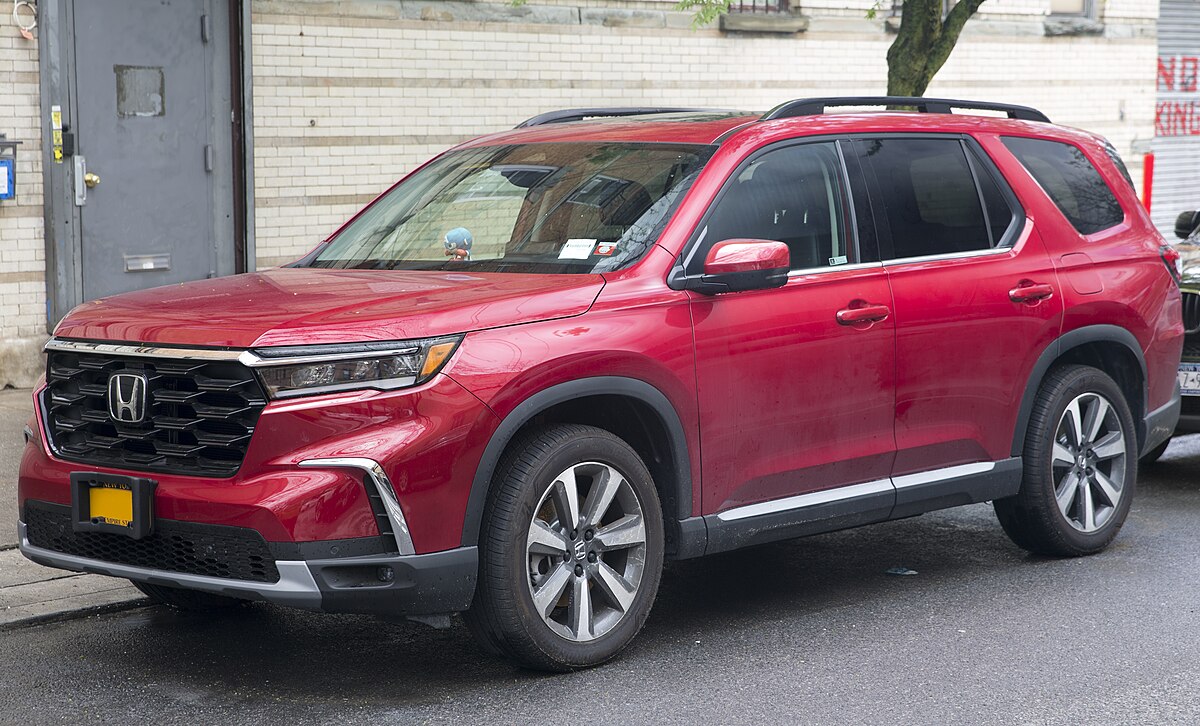
The second-row seats feature a one-touch folding mechanism that simplifies the process of expanding the cargo area, a thoughtful touch for those frequently switching between passenger and cargo configurations.
The Pilot also includes a hidden storage compartment beneath the cargo floor, perfect for keeping smaller items organized and secure. This underfloor storage area can be configured in multiple ways depending on your needs, adding another dimension of versatility to an already capable vehicle.
Tie-down anchors strategically placed throughout the cargo area provide secure attachment points for strapping down awkward or shifting loads.
Honda’s attention to practical details extends to the Pilot’s side panels, which are nearly vertical to maximize interior width. This design choice means that the full width of the vehicle is usable space, allowing large boxes to sit flush against the sides without wasted gaps.
The Pilot’s rear suspension is also tuned to maintain stability even when heavily loaded, ensuring that your cargo arrives safely without compromising handling characteristics.
For buyers who prioritize practical cargo solutions without moving up to a full-size SUV, the Honda Pilot delivers exceptional capability in a reasonably sized package.
Its thoughtful design choices and focus on real-world utility make it an ideal choice for those who regularly need to transport tall boxes and bulky items.
2. Kia Telluride
Since its introduction, the Kia Telluride has redefined expectations in the midsize SUV segment, earning widespread acclaim for its premium feel at a non-premium price point.
Beyond its handsome styling and upscale interior, the Telluride excels as a practical hauler with cargo capabilities that rival vehicles costing thousands more.
The Telluride’s cargo dimensions are immediately impressive, with 46 cubic feet behind the second row and a cavernous 87 cubic feet with all rear seats folded.
What makes these numbers particularly useful is the vehicle’s boxy, upright design that prioritizes interior volume over sleek aerodynamics. The rear liftgate opens to reveal a tall, wide aperture measuring approximately 49 inches in height, one of the most generous in its class.
This substantial opening eliminates the common frustration of having to angle large boxes to clear the upper portion of the hatch. Kia’s designers prioritized real-world functionality when crafting the Telluride’s cargo area.
The load floor sits at an ideal height for easy loading and unloading, while the rear bumper features a relatively low lift-over height to reduce strain when handling heavy items.
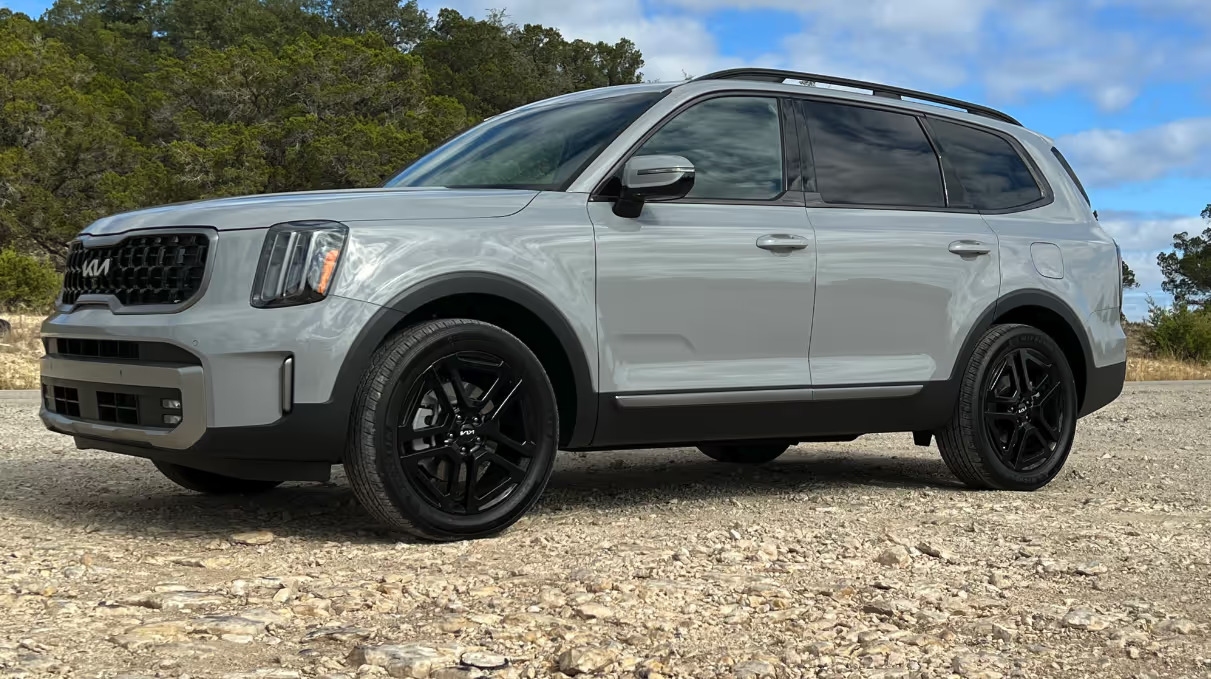
Once inside, cargo benefits from the Telluride’s squared-off interior dimensions, which maximize usable space rather than sacrificing it to stylistic curves or irregular shapes.
The second and third-row seats fold completely flat with minimal effort, creating a continuous cargo platform nearly 84 inches in length. This flat surface is ideal for sliding heavy boxes into place without catching on uneven transitions between folded seats.
The Telluride also features a smart power liftgate with height adjustment, allowing owners to set a custom opening height to accommodate their garage ceiling or personal preferences.
Throughout the cargo area, thoughtful details enhance everyday usability. Adjustable tie-down anchors help secure shifting loads, while side storage bins offer convenient places for smaller items that might otherwise roll around.
The Telluride also includes a hidden compartment beneath the cargo floor that’s perfect for storing emergency supplies or valuables out of sight. Perhaps most impressive is how the Telluride manages to deliver this exceptional utility without compromising on passenger comfort or driving dynamics.
Even when fully loaded with cargo, the vehicle’s well-tuned suspension maintains composure, and the powerful V6 engine provides ample thrust. The Telluride’s cabin remains quiet and refined regardless of what you’re hauling, making it an ideal companion for long-distance moving or shopping trips.
For buyers seeking maximum practicality without moving to a full-size SUV or minivan, the Kia Telluride represents one of the most thoughtfully designed options on the market.
Its combination of intelligent cargo engineering, premium features, and reasonable pricing make it a standout choice for those who regularly need to transport tall boxes and other bulky items.
3. Chevrolet Tahoe
The Chevrolet Tahoe stands as a quintessential American full-size SUV, representing decades of evolution in the art of combining passenger comfort with serious hauling capability.
While many vehicles claim versatility, the Tahoe’s traditional body-on-frame construction and intentionally boxy design create a cargo space that feels almost commercial in its practical utility.
With its most recent redesign, the Tahoe gained an independent rear suspension that dramatically improved interior packaging. This engineering change allowed Chevrolet to create a lower, flatter load floor while simultaneously increasing cargo volume.
The numbers tell an impressive story: 25.5 cubic feet behind the third row, 72.6 cubic feet behind the second row, and a cavernous 122.9 cubic feet with all seats folded. These figures place the Tahoe among the most capacious SUVs available outside the heavy-duty commercial segment.
What truly distinguishes the Tahoe for practical cargo hauling is its exceptional height clearance. The cargo area features nearly 56 inches of vertical space, easily accommodating tall furniture pieces, appliances, and stacked boxes that would need to be tipped or dismantled in smaller vehicles.
The rear hatch opening closely matches this interior height, minimizing the common frustration of having adequate interior space but being unable to maneuver items through the door.
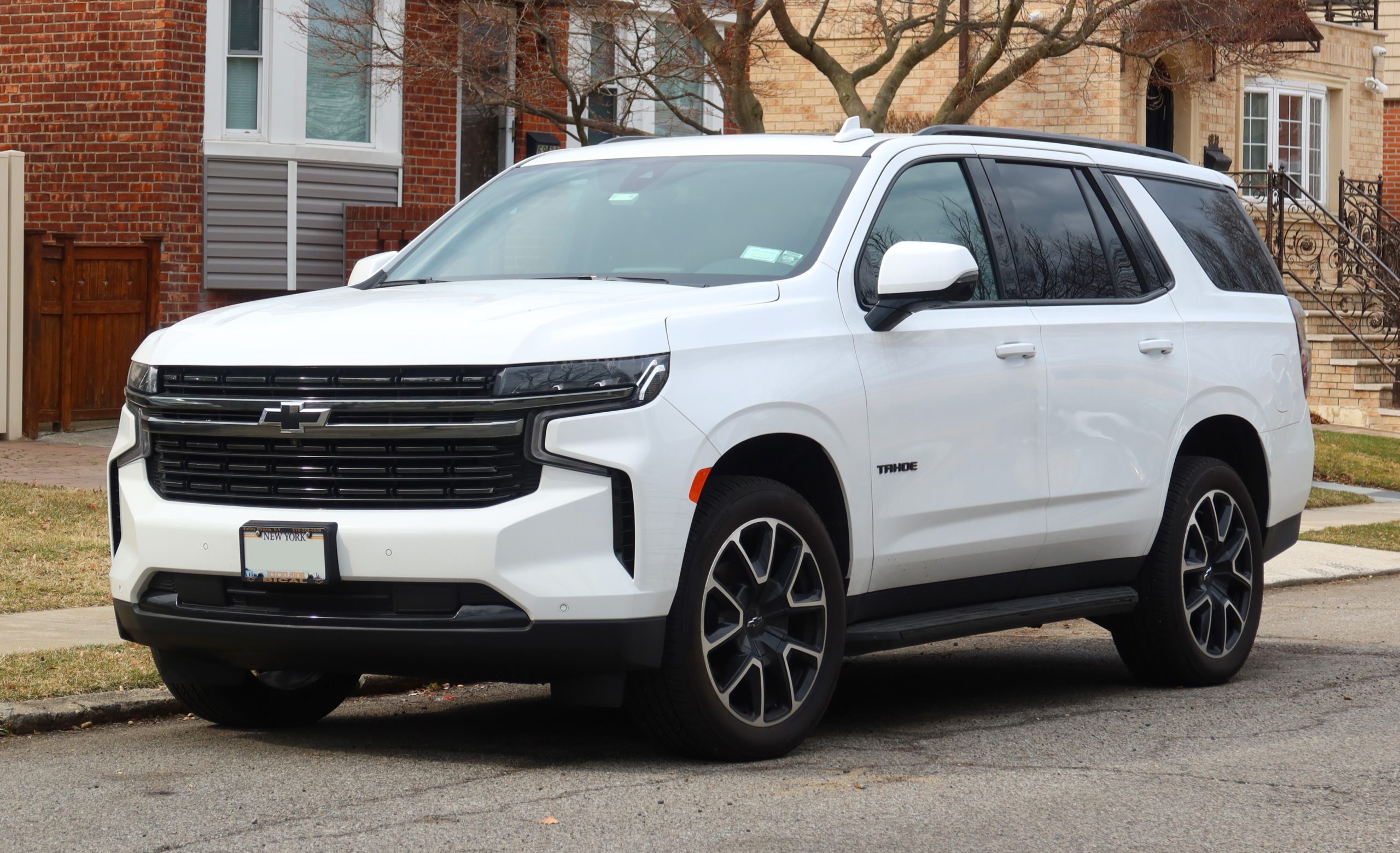
Chevrolet has equipped the Tahoe with power-folding second and third-row seats that can be controlled via buttons in the cargo area, allowing quick reconfiguration without opening multiple doors.
he resulting load floor stretches nearly 98 inches from the back of the front seats to the rear hatch, creating a truly van-like cargo area within an SUV body. The flat, uninterrupted nature of this space makes it ideal for sliding heavy boxes into place without needing to lift them over seat backs or floor transitions.
The practical advantages of the Tahoe extend to its loading height, which strikes an intelligent balance between ground clearance for off-road capability and accessibility for cargo loading.
The power liftgate can be height-adjusted to accommodate garage restrictions, and an available air suspension can lower the vehicle by approximately 2 inches when parked, further easing the loading process.
Beyond raw dimensions, the Tahoe includes thoughtful cargo management features that enhance its versatility. The available power-sliding center console can move backward to create additional front storage or forward to serve rear passengers.
Multiple tie-down points throughout the cargo area secure shifting loads, while the optional advanced trailering package integrates seamlessly with the vehicle’s electronics to make towing large items a straightforward experience.
For families or individuals who regularly transport tall, bulky items but still want the comfort and capability of a traditional SUV, the Chevrolet Tahoe represents one of the most practical solutions available.
Its combination of exceptional interior height, thoughtful features, and robust construction makes it an ideal companion for those who view cargo capacity as a non-negotiable requirement rather than an occasional convenience.
4. Jeep Grand Cherokee L
The Jeep Grand Cherokee L represents a significant evolution in Jeep’s lineup, adding a third row and extended length to the acclaimed Grand Cherokee formula.
While retaining the brand’s signature off-road capability, this elongated model brings something equally valuable to practical-minded buyers: exceptional cargo versatility with particular attention to vertical loading space.
Behind its third row, the Grand Cherokee L offers a respectable 17.2 cubic feet of cargo volume. With the third row folded, this expands to 46.9 cubic feet, and with both rear rows folded, the vehicle provides a substantial 84.6 cubic feet of cargo capacity.
These figures are competitive, but the true advantage of the Grand Cherokee L lies in how this space is configured. Unlike many modern SUVs that sacrifice function for sleek, sloping rooflines, Jeep has maintained a relatively boxy rear design that maximizes usable space.
The cargo area features nearly vertical walls and a high roof, creating a rectangular space that efficiently accommodates boxes and bulky items. The rear hatch opening measures approximately 47 inches in height, allowing for the loading of tall items without awkward maneuvering or tipping.
Inside, the cargo area maintains this height throughout, avoiding the tapering effect common in many competitors that reduces usable space toward the front of the cargo compartment.
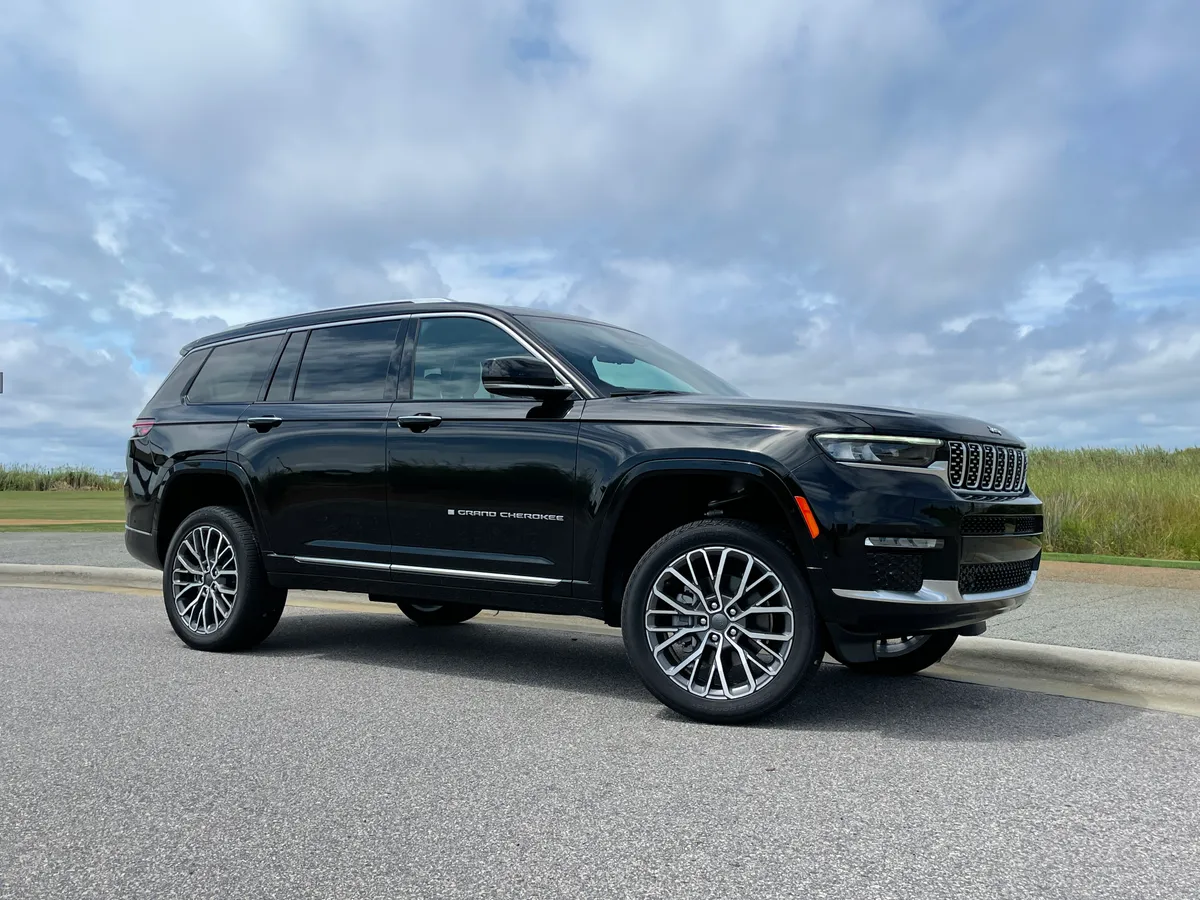
Jeep’s engineers have prioritized practical functionality in the Grand Cherokee L’s design. The load floor sits at a comfortable height from the ground, with a relatively low lift-over edge that reduces strain when loading heavy items.
Both the second and third-row seats fold completely flat with minimal effort, creating a continuous cargo platform that stretches nearly 79 inches from the back of the front seats to the rear hatch. This flat surface eliminates the frustration of items catching on raised sections or gaps between folded seats.
Adding to its versatility, the Grand Cherokee L features an available Quadra-Lift air suspension system that can lower the vehicle by 1.8 inches in “Park Mode,” further reducing the loading height for heavy cargo.
This system also adjusts automatically when driving to optimize aerodynamics and fuel efficiency without compromising the practical cargo space.
Throughout the cargo area, thoughtful details enhance everyday usability. Multiple tie-down points help secure shifting loads, while available cargo dividers can section off the space to prevent items from sliding around.
The Grand Cherokee L also includes subtly integrated side storage compartments perfect for storing smaller items that might otherwise roll around the main cargo area.
Perhaps most impressively, the Grand Cherokee L delivers this exceptional utility while maintaining Jeep’s legendary capability. Available with either the standard Quadra-Trac I, more advanced Quadra-Trac II, or top-tier Quadra-Drive II four-wheel-drive systems, it remains trail-ready despite its focus on practical cargo solutions.
This dual-purpose design makes it uniquely appealing to outdoor enthusiasts who need both off-road performance and the ability to transport bulky gear.
For buyers seeking a mid-to-large SUV that excels at accommodating tall cargo without moving to a full-size model, the Jeep Grand Cherokee L offers an ideal blend of versatility, capability, and refinement.
Its thoughtful cargo engineering makes it particularly well-suited to those who regularly need to transport full-height boxes and other bulky items.
Also Read: 8 Cars With Rear Center Armrests That Have Real Storage
5. Ford Expedition
The Ford Expedition stands as a testament to American engineering’s approach to full-size SUV design, prioritizing exceptional utility alongside modern comfort and technology.
As one of the largest SUVs in the mainstream market, the Expedition offers cargo capabilities that approach commercial-grade utility while maintaining the refinement expected in a family vehicle.
The Expedition’s cargo credentials begin with impressive raw numbers: 20.9 cubic feet behind the third row, 63.6 cubic feet behind the second row, and a massive 104.6 cubic feet with all rear seats folded.
In the extended-length Expedition MAX variant, these figures climb even higher to 36.0, 79.6, and 121.5 cubic feet, respectively. However, what makes these numbers particularly useful is the vehicle’s thoughtful packaging and nearly vertical surfaces that maximize usable space.
The Expedition’s cargo area features a tall, wide opening with minimal intrusion from the rear bumper or liftgate mechanisms. This clean design creates an exceptionally practical loading aperture measuring approximately 55 inches in height, easily accommodating tall furniture pieces, appliances, and stacked boxes.
The interior cargo space maintains this height throughout, avoiding the tapering effect common in many competitors that reduces usable volume toward the front of the cargo compartment.
Ford’s engineering team has created one of the most user-friendly cargo experiences in the segment. The Expedition features power-folding third-row seats that can be controlled via buttons in the cargo area, allowing quick reconfiguration without opening multiple doors.

The available second-row power-folding captain’s chairs similarly drop with minimal effort, creating a flat, continuous load floor that stretches nearly 96 inches from the back of the front seats to the rear hatch in the standard model (and even longer in the MAX variant).
Adding to its versatility, the Expedition includes Ford’s innovative Cargo Management System with adjustable shelving that can be configured in multiple positions. This system allows owners to create separate storage zones, preventing items from sliding around during transport.
The flat load floor features minimal intrusions from wheel wells or structural elements, maximizing the usable width for bulky cargo items. The Expedition’s practical advantages extend to its loading height, which strikes an intelligent balance between ground clearance for off-road capability and accessibility for cargo loading.
The power liftgate can be height-adjusted to accommodate garage restrictions, and the available air suspension can lower the vehicle’s rear end when parked, further easing the loading process for heavy items.
Throughout the cargo area, thoughtful details enhance everyday usability. Multiple tie-down points help secure shifting loads, while convenient side storage compartments offer dedicated spaces for smaller items.
The Expedition also features a hidden storage well behind the third row, perfect for securing valuables or emergency supplies out of sight. For families or individuals who regularly transport tall, bulky items but still want the comfort, technology, and capability of a modern SUV, the Ford Expedition represents one of the most practical solutions available.
Its exceptional interior height, thoughtful cargo management features, and robust construction make it an ideal choice for those who view substantial vertical cargo capacity as a primary purchasing consideration.
6. GMC Yukon XL
The GMC Yukon XL represents the pinnacle of full-size SUV utility, combining passenger luxury with cargo capabilities that rival many commercial vehicles.
As the extended-length variant of the standard Yukon, the XL model stretches its wheelbase and overall length to create truly exceptional cargo dimensions, particularly when it comes to accommodating tall, bulky items.
The Yukon XL’s cargo specifications immediately impress: 41.5 cubic feet behind the third row, 93.8 cubic feet behind the second row, and a cavernous 144.7 cubic feet with all seats folded.
These figures place it among the most capacious SUVs available to consumers, approaching the utility of dedicated cargo vans while maintaining the comfort and appointments expected in a premium family vehicle.
What truly distinguishes the Yukon XL for practical cargo hauling is its exceptional height clearance combined with its extended length. The cargo area features nearly 55 inches of vertical space throughout, easily accommodating tall furniture pieces, appliances, and stacked boxes that would need to be tipped or dismantled in smaller vehicles.
This interior height is complemented by a rear hatch opening that closely matches these dimensions, eliminating the common frustration of having adequate interior space but being unable to maneuver items through the door.
GMC has equipped the Yukon XL with power-folding second and third-row seats that can be controlled via buttons in the cargo area, allowing quick reconfiguration without opening multiple doors.
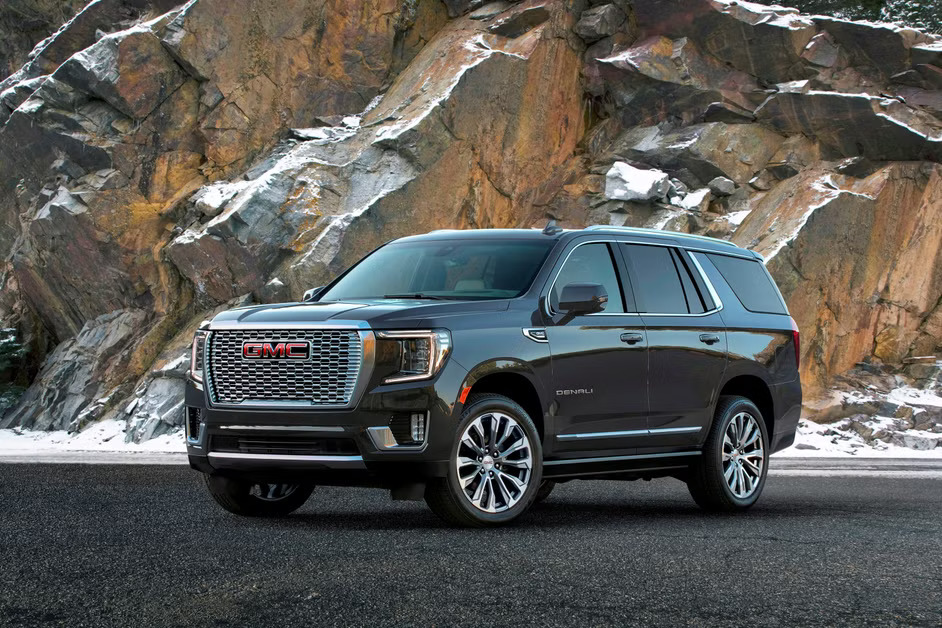
The resulting load floor stretches an impressive 104 inches from the back of the front seats to the rear hatch, creating a truly van-like cargo area within an SUV body.
The flat, uninterrupted nature of this space makes it ideal for sliding heavy boxes into place without needing to lift them over seat backs or floor transitions.
The practical advantages of the Yukon XL extend to its loading height, which strikes an intelligent balance between ground clearance and accessibility.
The power liftgate can be height-adjusted to accommodate garage restrictions, and the available Adaptive Air Ride Suspension can lower the vehicle by approximately 2 inches when parked, further easing the loading process for heavy items.
GMC’s premium approach to utility is evident in the thoughtful cargo management features throughout the Yukon XL. The vehicle includes multiple tie-down points, convenient side storage compartments, and an available advanced organization system with adjustable dividers.
For those who frequently transport a combination of cargo types, these features allow for intelligent separation and security of various items. The Yukon XL’s independent rear suspension a relatively recent addition to the platform creates a lower, flatter load floor compared to previous generations, simultaneously improving cargo capacity and ease of use.
This engineering change represents a significant advancement in making the vehicle’s substantial dimensions translate directly to usable space rather than being compromised by mechanical intrusions.
For families or individuals who regularly transport exceptionally tall or bulky items over long distances, the GMC Yukon XL represents perhaps the ultimate consumer-grade solution. Its combination of luxury appointments, robust construction, and commercial-grade cargo dimensions makes it uniquely suited to those who refuse to compromise on either comfort or utility.
While its size requires consideration for parking and maneuverability, for those who prioritize maximum cargo capacity particularly vertical clearance few vehicles can match its practical capabilities.
7. Toyota 4Runner
The Toyota 4Runner stands as an intriguing outlier in today’s SUV world a rugged, body-on-frame midsize SUV that prioritizes genuine off-road capability and functional utility over car-like road manners.
While many competitors have evolved toward crossover-style unibody construction, the 4Runner’s traditional SUV architecture creates unique advantages for cargo hauling, particularly when it comes to accommodating tall boxes and bulky items.
With the rear seats in use, the 4Runner offers 47.2 cubic feet of cargo space, expanding to a generous 89.7 cubic feet with the second row folded. While these numbers are impressive, they tell only part of the story.
The 4Runner’s distinctly boxy, upright design creates a cargo area with exceptionally vertical walls and minimal tapering, maximizing the usability of every cubic foot.
Unlike many modern SUVs with fashion-forward sloping rooflines that compromise cargo functionality, the 4Runner makes no such concessions. The 4Runner’s cargo area features a tall, wide opening with a relatively low lift-over height considering its substantial ground clearance.
This practical design creates a loading aperture measuring approximately 48 inches in height, easily accommodating tall boxes and bulky gear. The interior cargo space maintains consistent height throughout, avoiding the narrowing effect common in many competitors that reduces usable space toward the front of the cargo compartment.
Toyota’s engineers have focused on creating genuinely usable space rather than impressive but impractical volume measurements. The 4Runner features a sliding rear cargo deck on many trims a unique offering that can support up to 440 pounds and extends nearly 18 inches outward when the liftgate is raised.
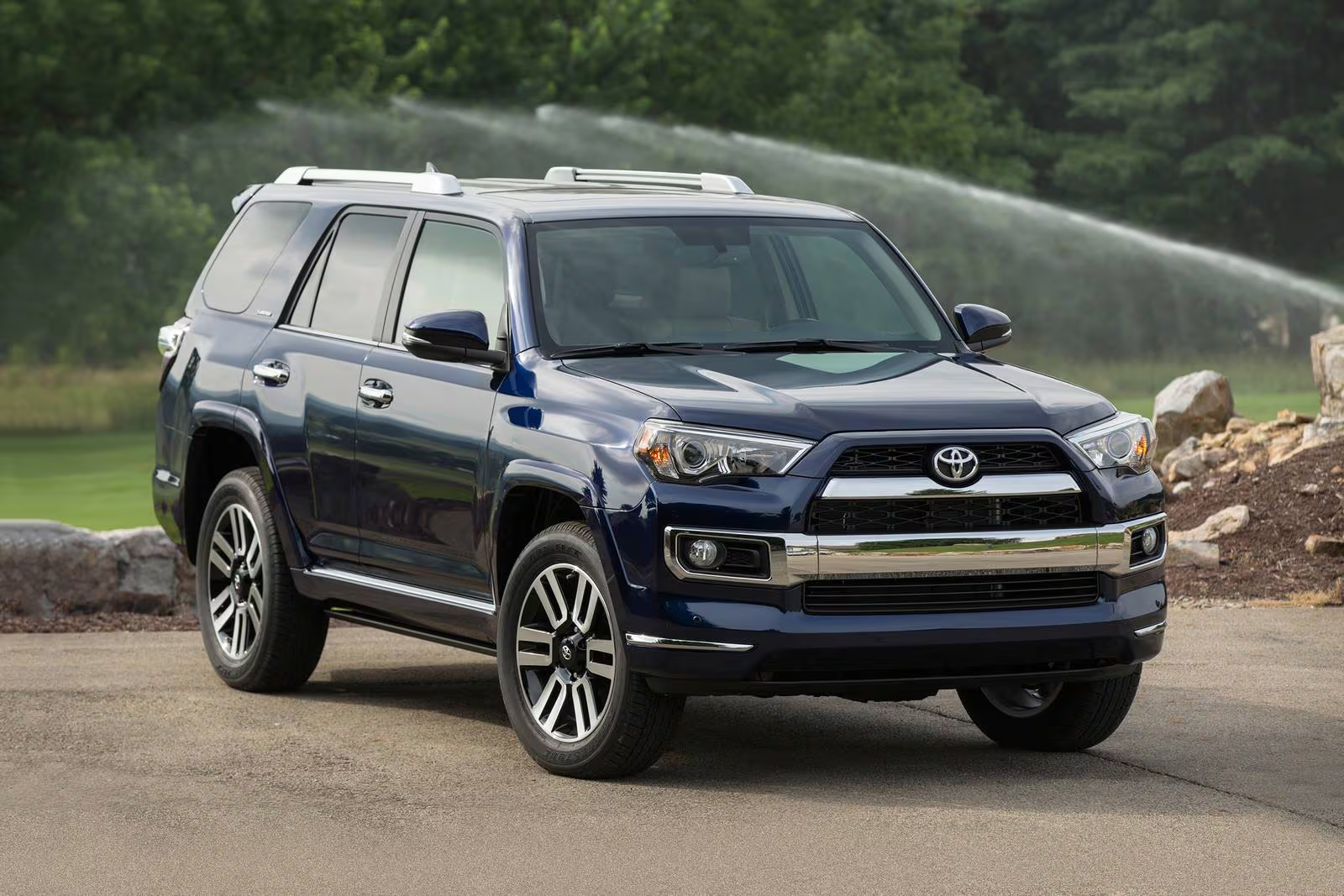
This innovative feature dramatically reduces strain when loading heavy items, allowing users to slide cargo onto the deck outside the vehicle before pushing it inward rather than lifting and carrying it into the cargo area.
The second-row seats fold completely flat with minimal effort, creating a continuous cargo platform stretching over 72 inches from the back of the front seats to the rear hatch.
This flat surface eliminates the frustration of items catching on raised sections between folded seats, a common issue in many competitors. The resulting cargo floor sits at a comfortable height for loading and unloading heavy items.
Throughout the cargo area, practical features enhance everyday usability. Multiple tie-down points help secure shifting loads, while the durable, hard plastic surfaces throughout the cargo compartment resist damage and clean easily after transporting dirty or wet gear.
Many trims include a 120V AC power outlet in the cargo area, perfect for powering equipment at remote work sites or campgrounds. The 4Runner’s traditional body-on-frame construction provides advantages beyond just cargo capacity.
Its robust build quality and proven reliability make it an ideal choice for those who regularly transport heavy items over rough terrain or in challenging conditions.
Unlike some more delicate crossover SUVs, the 4Runner is designed to handle substantial loads without compromising its structural integrity or performance.
For outdoor enthusiasts, contractors, or anyone who values practical utility over the latest automotive fashion trends, the Toyota 4Runner offers a compelling combination of cargo capability, off-road performance, and legendary durability.
Its exceptional vertical cargo clearance makes it particularly well-suited to those who regularly need to transport tall boxes, bulky equipment, or adventure gear without the size penalties of a full-size SUV.
Also Read: 10 Compact Cars With Back Seats Better Than Midsize Sedans

